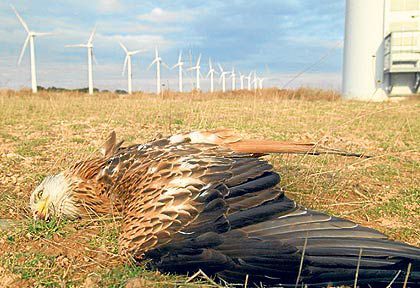
A proposed rule by the U.S. Fish and Wildlife Service is designed to streamline the permitting process that wind developers go through for eagle “takes,” which refers to killing or seriously disrupting the lives of eagles.
The rule has some conservationists concerned that, if it became final in its current form, it would weaken protections for eagles, especially in the key corridors of southeast Wyoming, while reducing the ability for the public to participate in the permitting process.
Anne Brande, executive director of the Albany County Conservancy, told Cowboy State Daily that by extending eagle-take permits to so many projects in southeast Wyoming, they’re potentially extending past how much mortality rates eagles can handle.
“Which is scary,” Brande said.
Too Much Red Tape
Wind developers are not legally required to get an eagle take permit for their wind farms, but if the project kills or causes a serious disturbance to eagles or their nests, it can be a violation of the Bald and Golden Eagle Protection Act (BGEPA).
Violations of the act can lead to prosecution and criminal sanctions.
After the bald eagle was removed from the Endangered Species Act, the BGEPA filled a gap to ensure the national bird and golden eagles were protected.
Companies developing projects, whether it be wind farms, pipelines or anything that could take eagles, were running into issues because their eagle take permits lasted only five years. The projects were expected to last decades and the burden of getting permits every five years became a problem. So in 2016, the duration was extended to 30 years, among other changes.
Wind farm developers, however, still pushed for a more streamlined process that would expedite the permitting process.
“They still say there’s just too much red tape, too much bureaucracy,” Bill Eubanks, public interest environmental lawyer, told Cowboy State Daily.
So last year the FWS proposed rules that would speed the process up.
Limbo
Not much movement has been made since the rule was proposed, but Eubanks said he expects that it will be finalized before the end of the Biden administration.
Eubanks said multiple groups have commented on the proposed rule and everyone is in a “sort of limbo” now as they wait to see anything final come out of it.
“My personal view is that there are some real concerns with it. They are bending over backwards for certain interests,” Eubank said.
He said that typically when these processes are streamlined, safeguards are removed.
“It’s the eagles that are going to take the brunt of that,” Eubanks said.
He said that when the process moves more quickly, it also gives the public less time to participate.
“Scientists and other experts just don’t have as much opportunity to provide their input,” Eubanks said.
Hard To Know
Lewis Grove, director of wind and energy policy with the American Bird Conservancy (ABC), told Cowboy State Daily that bird conservation groups, including the ABC, wanted a framework for an effective eagle take program.
Because the rule hasn’t been finalized, it’s hard to know for certain if it will weaken or strengthen protections for eagles.
“The devil is in the details,” Grove said. “In a broad sense, if the numbers are good, in the right spots, it absolutely could be a positive thing for eagle conservation.”
Grove said for many years, wind projects have been taking eagles and other birds. The Department of Justice and the FWS have been reluctant to really prosecute the operators for violating BGEPA, in part because there’s a priority to reduce carbon dioxide emissions.
“So, they’ve been looking at other ways to address this ‘take’ without having to bring down criminal penalties against companies for it,” Grove said.
Responsible Development
He said the goal is to encourage responsible wind energy development, and there’s a balance that’s hard to strike with those two goals.
One provision the ABC wants is areas that have dense eagle concentrations, where there’s not much that can be done to mitigate harm to the birds, be designated as no-development zones.
The proposed rule did not have that provision. Instead, it created two categories on the map that created general permits and specific permits instead of a category that would exclude them altogether.
“One of our concerns is areas like southeastern Wyoming, where the Albany County Conservancy is working,” Grove said.
The Carrot
Grove said that there are some rapidly developing technologies, such as AI cameras that identify eagles living near the turbines and shut them down when the birds get too close.
These technologies, however, are expensive, and the FWS doesn’t require anybody to use them aside from a couple exceptional cases.
“It’s the kind of thing that if they don’t have to do it, they’re not going to,” Grove said.
Wind developments require a lot of planning, such as the purchase power agreements that contract with someone to buy the power the farm produces.
These agreements are made long before the farm is operational.
“We get that it’s tough for the industry to have uncertainty around these things,” Grove said.
The goal of the proposed rule was to be a carrot so they’d participate in a permitting program, he said. In exchange, they get more certainty about costs.
Keeping The Peace
Eubanks said that there are mixed opinions on the proposed rule.
“Some people love it, and some people hate it,” he said.
On behalf of a couple clients, he had a discussion with the director of the FWS about the proposed rule.
He was told that the rule isn’t a congressional requirement. There was no direction given on how to do anything with the permitting process. It was just a way to make the permitting process more effective and efficient for everyone.
“They think it would keep the peace and keep everyone happy, including the industries that are applying for these permits,” Eubanks said.
ENB Top News
ENB
Energy Dashboard
ENB Podcast
ENB Substack

